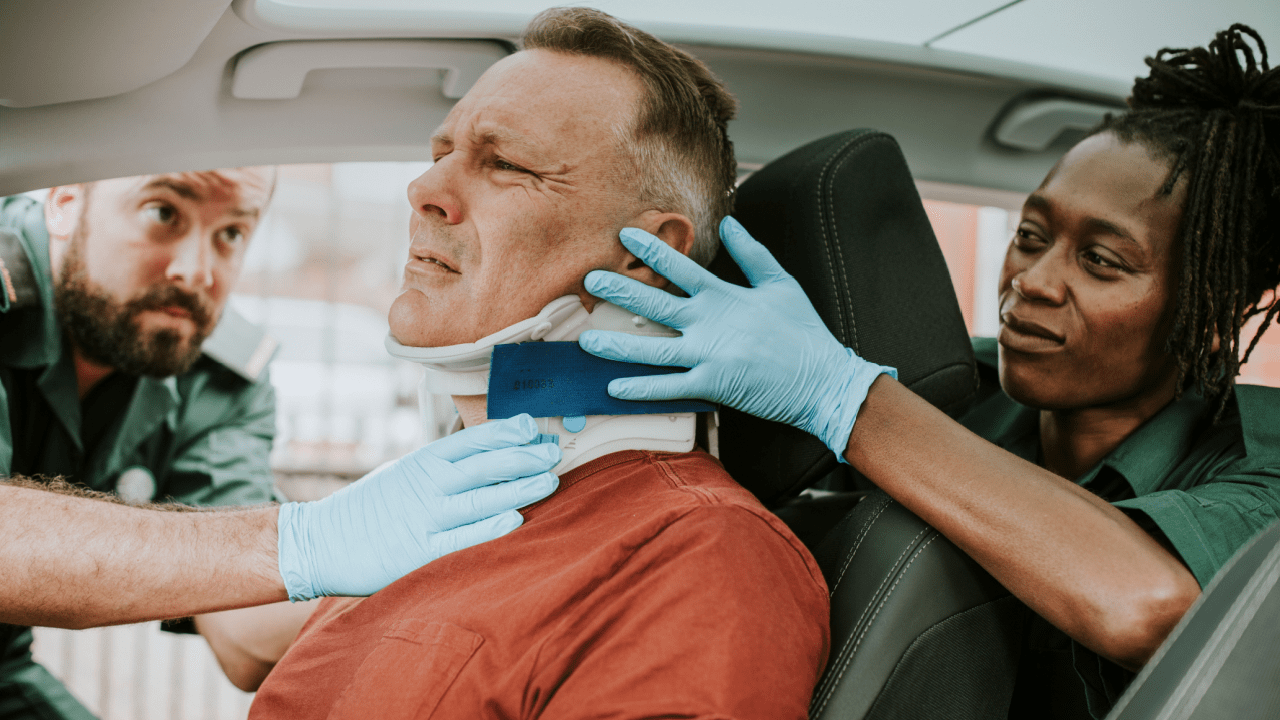- Mon - Fri: 8.30 AM - 5:00 PM
- 26565 Agoura Rd., 200, Calabasas, CA 91302
- 818-884-8075

How Do You Get Whiplash in a Car Accident? Causes & Symptoms Explained
Crash Impact Insight: How Whiplash Occurs in Car Accidents
If you’ve recently been in a crash and are experiencing neck pain, stiffness, or headaches, you might be wondering: How do you get whiplash in a car accident? Whiplash is one of the most common injuries following a vehicle collision—and one of the most overlooked, especially in low-speed accidents.
This article explains how whiplash occurs, why it happens even in minor crashes, and what symptoms to watch for. Understanding how you get whiplash in a car accident is the first step toward getting proper treatment and protecting your health and rights.
Injury Overview Breakdown: What Whiplash Is and Why It’s Common
Whiplash is a soft tissue injury to the neck. It occurs when the head is suddenly jerked backward and then forward—similar to the motion of a whip cracking. This movement strains muscles, ligaments, and tendons in the neck and upper back.
Why It’s Common:
- Rear-end collisions are the most frequent cause of whiplash
- Even crashes at speeds under 15 mph can result in injury
- Whiplash doesn’t always show up on imaging tests, making it harder to detect
- It can take hours—or days—for symptoms to appear
One of the biggest myths is that you can only get whiplash in a car accident if the crash is severe. In reality, many people suffer whiplash in minor fender benders—especially when they’re caught off guard and unable to brace for impact.
Crash Dynamics Explained: How Whiplash Happens During Impact
To understand how you get whiplash in a car accident, it helps to look at what happens inside the vehicle during a crash.
When your car is hit—especially from behind—your body is pushed forward with the seat. However, your head lags behind momentarily, then snaps forward in response. This unnatural, rapid motion stretches the muscles and ligaments in your neck beyond their normal range.
Factors That Contribute to Whiplash:
- Rear-End Collisions: These cause the most sudden head movement, increasing whiplash risk
- Low-Speed Impact: Even at slow speeds, a crash can transfer enough force to injure the neck
- Seatbelt Use: While seatbelts prevent more serious injuries, they also hold the torso in place—causing the neck to absorb more of the force
- Headrest Positioning: A poorly adjusted headrest increases the distance your head can move before contact, worsening the injury
You don’t need to hit your head or be knocked unconscious to get whiplash in a car accident. The motion itself is enough to cause damage, especially if you’re not expecting the impact.
Injury Warning Signs: Symptoms of Whiplash After a Car Accident
Whiplash symptoms can show up immediately, but many people experience delayed symptoms hours or even days after the crash.
Common Symptoms Include:
- Neck pain and stiffness
- Limited range of motion in the neck or shoulders
- Headaches that start at the base of the skull
- Pain in the upper back, arms, or between the shoulder blades
- Dizziness, blurred vision, or fatigue
- Tingling or numbness in the arms
- Difficulty concentrating or sleeping
Because these symptoms overlap with other conditions, some people ignore them or delay seeking help—making their recovery longer and complicating any potential legal claim.
Medical Urgency Guide: Why Prompt Care Matters for Whiplash
If you suspect you got whiplash in a car accident, see a doctor as soon as possible—even if your symptoms seem mild. Early diagnosis helps guide your treatment plan and improves your chances of full recovery.
Medical records also play a major role in:
- Insurance claims
- Personal injury lawsuits
- Workplace leave or disability documentation
Without timely medical documentation, insurers may question the legitimacy or severity of your injury. They might argue that your symptoms were pre-existing or unrelated to the accident.
Types of Treatment:
- Pain medication and anti-inflammatories
- Physical therapy
- Heat or ice applications
- Gentle stretching and range-of-motion exercises
- Chiropractic care (in some cases)
Consistent follow-up care shows that you’re taking your recovery seriously—and that your injury is real and impactful.
How Do You Get Whiplash in a Car Accident? Reminders for Injury Victims
If you’ve experienced whiplash, early and continuous care is essential. Follow these steps:
- Get examined within 24–48 hours
- Keep a daily injury log
- Attend all medical appointments
- Save bills and doctor’s notes
- Start a whiplash claim if needed
Get Legal Help If You Got Whiplash in a Car Accident
If you’re dealing with the pain, bills, or uncertainty of a whiplash injury, you don’t have to go through it alone. Legal Brand Marketing helps connect injured victims with personal injury lawyers who specialize in accident claims. Get matched with an attorney who can protect your rights and fight for the compensation you deserve.
Frequently Asked Questions (FAQs)
1. Can whiplash happen even in minor accidents?
Yes. Even low-speed crashes can generate enough force to cause soft tissue injuries like whiplash.
2. Do airbags prevent whiplash?
Not necessarily. Airbags protect against impact injuries but don’t stop the neck’s motion during rear-end collisions.
3. How soon should I see a doctor for whiplash?
Ideally within 24–48 hours of the crash—even if symptoms seem mild or delayed.
4. Can I still get compensation for whiplash without X-rays?
Yes. Whiplash is a soft tissue injury, and clinical records from a doctor or therapist are valid proof.
5. Should I go to a chiropractor for whiplash?
Some whiplash sufferers find relief with chiropractic care. Talk to your doctor about whether it’s right for you.
Key Takeaways
- Whiplash is caused by a rapid back-and-forth motion of the neck during a collision
- Rear-end accidents are the most common cause of whiplash
- Symptoms can be delayed and may worsen over time
- Medical documentation is essential for your claim
- Legal guidance can help you recover compensation if your claim is denied or underpaid
Contact Us
Recent Posts

Auto Accident Leads
How Do I Find Corporate Bankruptcy Filings? A Guide for Legal and Business Professionals
Read More »
September 30, 2025



